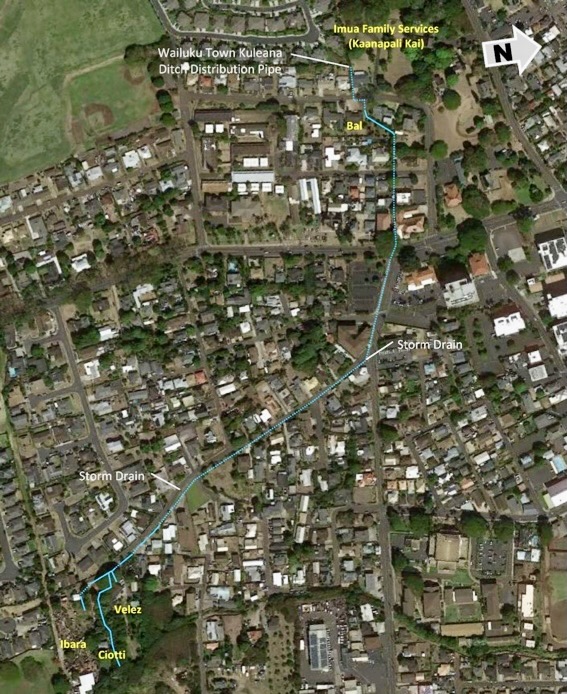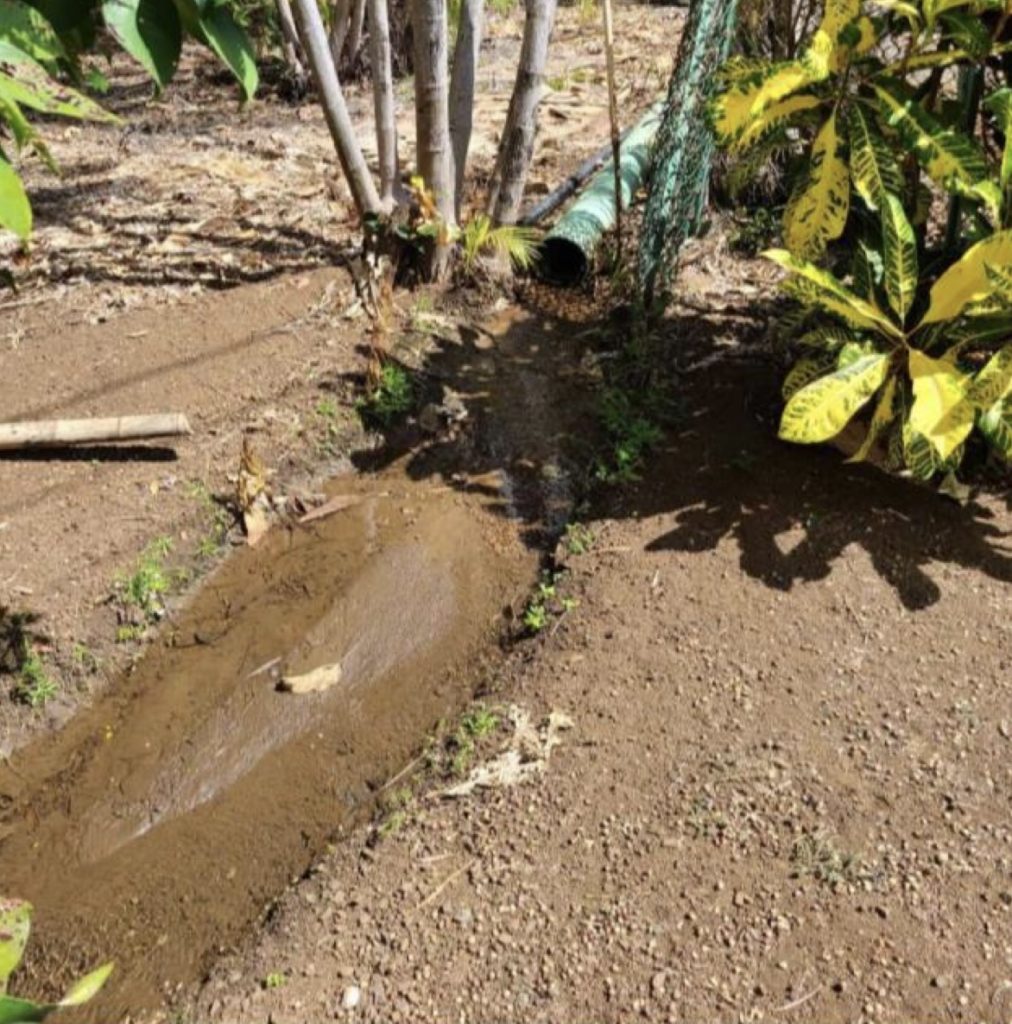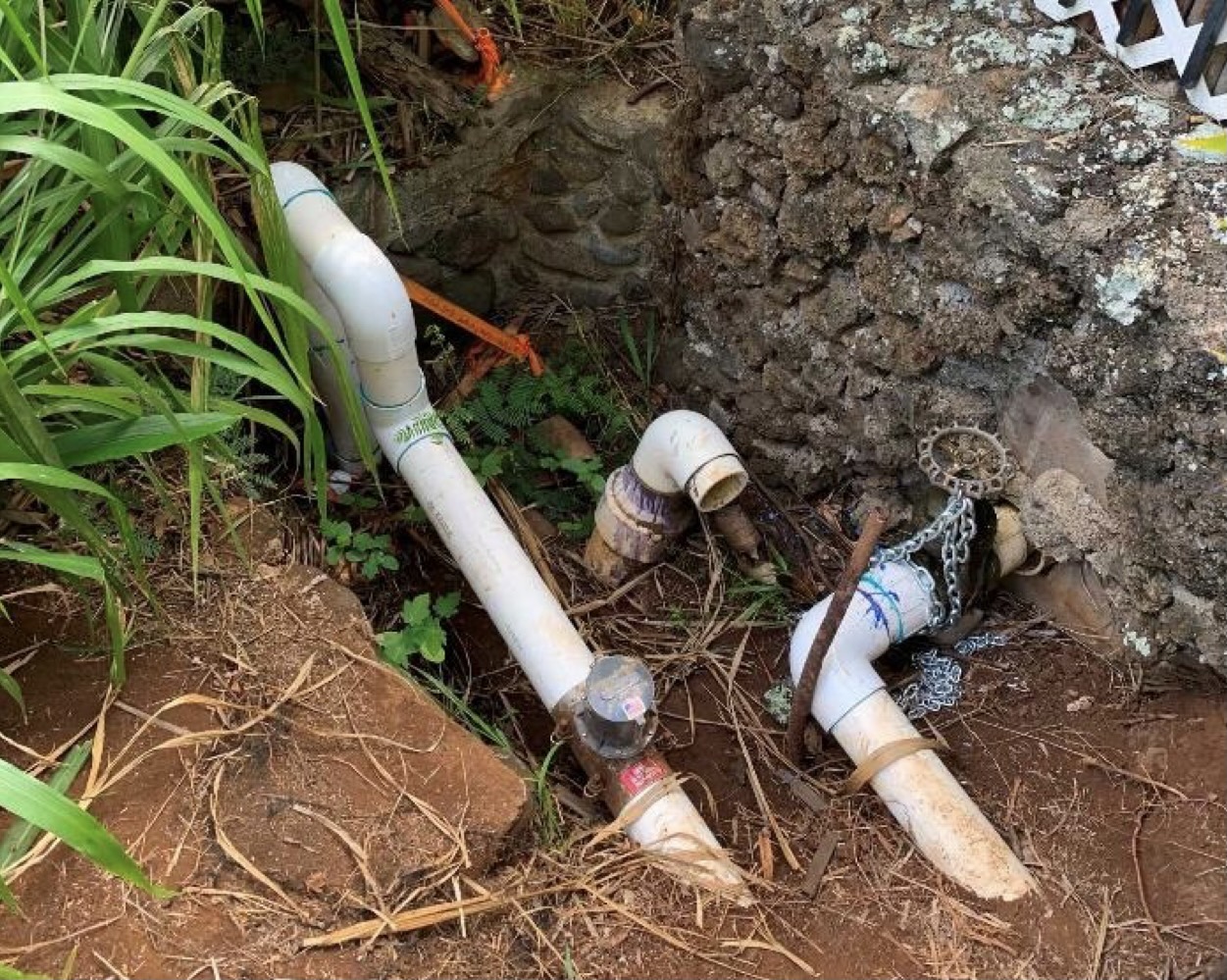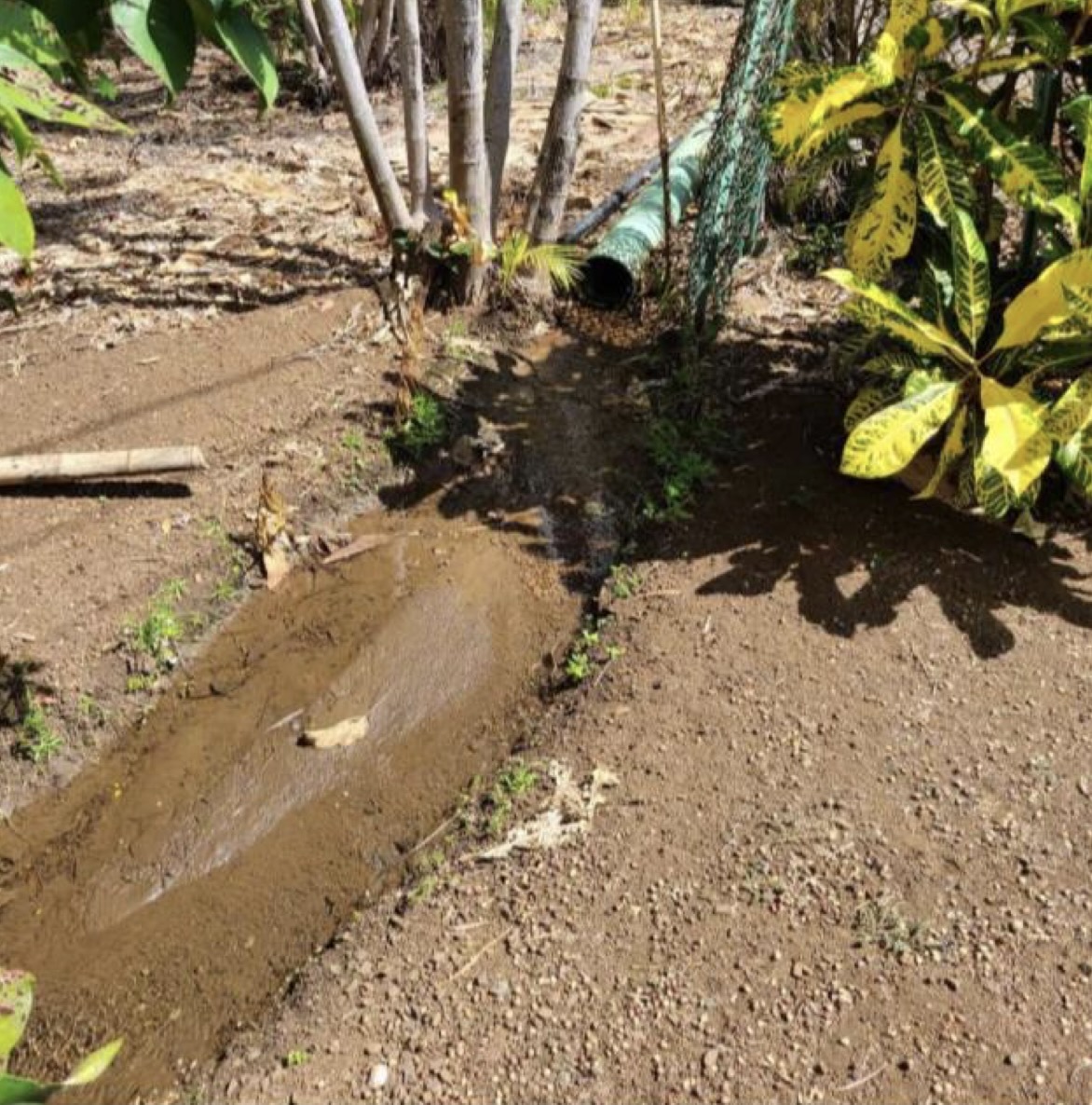Photo: The chained water valve and pipe that releases water into the Wailuku Town kuleana ʻauwai. Credit: CWRM
By Teresa Dawson
The heavy lifting is far from over.
Nearly 20 years ago, Hui o Nā Wai ‘Ehā and the Maui Tomorrow Foundation filed their petition to amend the interim instream flow standards for Waikapū, Waiheʻe, North and South Waiehu streams and Wailuku River, known collectively as Nā Wai ‘Ehā.
Since then, the state Commission on Water Resource Management has designated the Nā Wai ‘Ehā watersheds as surface water management areas, adopted new interim instream flow standards, and, last summer, it issued its Findings of Fact, Conclusions of Law, and Decision and Order in the contested case on water use permits in the area.
That last decision articulated who would receive a water use permit and why, how much water they should get, and what the water would be used for.
Many of the parties in that contested case filed appeals with the Hawaiʻi Supreme Court last fall. Meanwhile, Water Commission staff have been working to help enforce the decision’s provisions so that water is going to those who are supposed to have it.
As Environment Hawaiʻi reported last October, permittees with kuleana rights to water from South Waikapū Stream reported that they were not receiving the water they are entitled to. Some claimed that Wailuku Water Company, which owns and operates the old sugarcane plantation ditch system that diverts the streams, was improperly restricting flows. They also complained that others with lower priority permits or no permit at all were drawing water from the system before they got their share.
That month, the Water Commission took steps to ensure that a farm that didn’t have a permit for water from South Waikapū Stream stopped drawing water from the system. (Read more on that elsewhere in this issue.) But the problem of maintaining the ʻauwai that feeds the kuleana lots, or reviving the traditional ʻauwai to bypass the ditch system, remains: Both cross private land.
These same problems — and more — plague the taro farmers at the end of the Wailuku Town kuleana ʻauwai.
“This is a South Waikapū kuleana issue all over again,” Hui o Nā Wai ‘Ehā president Hōkūao Pellegrino told the commission at its January 18 meeting.
Dean Uyeno, head of the Water Commission’s stream protection and management branch, briefed commissioners that day on the heated tug-of-war between the Wailuku Water Company and Robert Street, who farms taro on one of the kuleana properties at the end of the ʻauwai.
Since last October through last month, Street has repeatedly engaged in what WWC president Avery Chumbley calls “self-help vandalism,” opening a valve and even cutting the chain on it to allow more water to flow from the company’s Waiheʻe ditch into the top of the ʻauwai.
Chumbley insists that his company has been meeting and at times exceeding the Decision and Order’s requirement that 88,000 gallons a day be released into the ʻauwai.
The commission had intended for the kuleana users to take responsibility for maintenance of their ʻauwai and to work out on their own how to make sure they received their due, assuming that the amount of water the D&O required to be released into the ʻauwai was actually there.
In the case of the Wailuku Town kuleana ʻauwai, there are only four users. Imua Family Services, located near the top, takes water from a pipe controlled by WWC that then goes underground for about 200 feet. The ʻauwai crosses a couple of properties, then runs past the Wailuku public library. Further down, a couple of storm drains intersect the ʻauwai, which then resurfaces toward the end of Kalua Road. After that, it passes through several culverts and under driveways before it comes to a junction that serves the final three users, all of whom grow taro.

Where’s the Water?
On September 29, the Water Commission received an email from Street, who grows taro on Jordanella Ciotti’s property. Ciotti received a water use permit for 8,265 gallons per day from the ʻauwai to grow kalo, although she was recognized to have appurtenant rights to 34,500 gallons per day of water.
According to a commission staff report, Street was angry about not receiving enough water. He followed up with a phone call on October 7, complaining that the water coming to his farm was a mere trickle.
A few days later, WWC’s Chumbley reported to the commission that somebody had vandalized the valve that releases water into the ʻauwai.
Throughout October, November, and into December, Street continued to complain about insufficient or no water, while Chumbley reported repeated vandalism of the valve.
Street told commission staff that the Wailuku Water Company used to maintain the ʻauwai when sugarcane was still being grown and also used to fully open its valves and release water to the kuleana landowners three days a week. Since the commission’s Decision and Order, WWC has chosen to try to release just 88,000 gallons every day. While some of the company’s meter readings suggest that amount and sometimes more is, in fact, being released, Street submitted photos of WWC’s meter to the commission that seemed to indicate no water was being released at times.
In one of his many emails he stated: “The only business WWC has in the Wailuku Town ʻauwai system, is [to ensure] that the valve that comes directly off of Waihe’e ditch remains in the open position. This valve is the start of the Wailuku Town ʻauwai system. Our files also indicate that the minimum flow before we were cut off was 160,000 gallons per day. We are legally entitled to water that we were accustomed to, to satisfy our needs to grow kalo and other agricultural products we grow.
“It is not our responsibility to do your job by continuously sending photos to verify what is ‘oiā’i’o (true or real). This has become an overused copout by the CWRM. The situation has become so untenable, that what little trust we had in you and your team is gone,” Street stated. He also repeatedly called for commission deputy director Kaleo Manuel to be fired.
Chumbley was equally incensed. After the eighth time Street vandalized the distribution pipe, Chumbley wrote to Water Commission chair Suzanne Case, “As I have stated in the past to the staff and now directly to you Chair Case, I am requesting that the CWRM take a formal action to revoke Permit # 2247 to Ciotti based on these blatant and continued actions of self-help/theft and waste of water, which is clearly allowed and stated as a consequence under the D&O. WWC will continue to pursue with the MPD and Maui Prosecutor’s office criminal property damage and criminal trespass charges against Mr. Street.”
He later wrote, “WWC is providing the delivery drop at the [ʻauwai] distribution point. Mr. Street MAY have little to no water due to the condition of the ʻauwai, NOT that WWC is withholding the deliveries.”
On October 29, commission staff did a site visit and attempted to do a “back of the envelope calculation” of how much water was reaching the kuleana farmers. Using a leaf to try to determine flow velocity, Dean Uyeno of the commission’s stream protection and management branch said he believed the flow at the time was just above the permitted amount. The branch’s Ayron Strauch later tried again, using a different method, and found that WWC was likely not meeting the 88,000 gallons per day minimum flow into the ʻauwai. However, Uyeno, said, that estimate had a 20 percent chance of being accurate because the measuring device Strauch used doesn’t perform well in such low flows.

‘Excuse my language’
While the commission intended for kuleana users to take charge of managing their ʻauwai once WWC drops the required minimum amount of water into it, this case involved some unforeseen complications and has forced staff to seek guidance.
Uyeno posed the following questions to the commission: Who has the responsibility to manage the Wailuku Town kuleana ʻauwai and where should WWC provide the 88,000 gallons per day required by the D&O?
Whether the release point is at the end of WWC’s Waiheʻe ditch or at the distribution valve about 800 feet makai, Uyeno said, the amount may need to be increased due to apparent losses from the ʻauwai.
Staff has so far been unable to quantify those losses because a lot of the system is underground, he said.
Manuel noted that it took more than a decade for the commission to take action on all of the water use permit applications for Nā Wai ‘Ehā. And in that time, landowners changed, as did the scope of uses on the properties. So the amount of water that the original permit applicants asked for may now be insufficient, he said. What’s more, he added, no one ever took a baseline measurement of the water that WWC was releasing pre-D&O, when it was fully opening its valves three times a week.
To make sure the kuleana users are getting enough water, Manuel suggested that the commission could have WWC return to its pre-D&O release practice and release something like 100,000 more gallons a day into the ʻauwai. He pointed out that the three end users have appurtenant rights totaling 347,000 gallons per day, so there is a potential to award them more water.
For kuleana users in rural areas, where ʻauwai are more traditionally designed, having users manage it is workable, Manuel argued.
“In this case, you have a system that’s in an urban built environment that’s a relic of its time, that’s lasted the building of streets and other infrastructure … It still exists, but has a lot of layers on top of it. Easily managing that system … is almost impossible,” he said.
He said that in addition to just receiving more water from the ʻauwai system, the end users could perhaps hop onto the county water system. The Department of Water Supply would have to evaluate whether it had the infrastructure to do so, and the users would then become paying customers, he continued.
Commissioner Mike Buck thanked Manuel and his staff for trying to find a resolution.
“As a commission, we can make broad policy calls and we knew there would be some horrible implementation issues. This is an example of that,” Buck said.
“It would be great if we could just stick to our decision and order and tell everyone else, ‘You figure it out as long as the water WWC is responsible for is available at the top of that,’” Buck said, admitting that that was perhaps naive. “We were looking for community leadership that didn’t have to come from the water commission staff. … I hope that still might be possible.”
The dispute over where the ʻauwai starts needs to be resolved before that can happen, Manuel suggested. If it starts at the end of the ditch, then it wouldn’t be up to WWC to decide what comes out of the valve at Imua Family Services. However, WWC says that the valve is where they always used to release of water into the ʻauwai.
“Who gets to manage the ʻauwai is really important. We may need to clarify or amend the D&O because it was broadly written,” Manuel said.
Buck agreed that it was definitely the commission’s responsibility to determine that.
Manuel also pointed out that the ʻauwai itself “has various formal and informal records of existence. Portions of it do have its own easement on maps. … Others are just drawings on TMKs. No formal easement or access rights to anybody.”
He mentioned that Earthjustice, in its exceptions to the Water Commission’s D&O, argued that kuleana tenants have access rights to ʻauwai on private property.
Commissioners discussed the possibility of fixing the ʻauwai to reduce system losses. While the D&O considered documented losses from WWC’s main ditch system, there was no evaluation or record of system losses from distribution lines or ʻauwais.
“It seems like that was something that was forgotten but something that’s clearly coming back to, excuse my language, but bite us in the ass,” commissioner Aurora Kagawa-Viviani said.
“These are things we’re learning from,” Manuel said, adding that he hoped the commission will be able to get information from future water use permit applicants on where their water comes from, whether it’s from an unlined ʻauwai, etc.
Public Testimony
When it was the public’s turn to testify, it was clear that the beef between Street and Chumbley was still very much alive. Chumbley again alleged property damage and trespassing by Street. “The most recent just happening January 13 for the tenth time now. There are videos and witnesses … We are still in discussions with the prosecutor’s office and may press criminal charges later on,” Chumbley said.
Street, on the other hand, argued that as kuleana tenants, “we have an implied easement. We are not trespassing and they never understood that.”
Chumbley claimed that his recent water meter readings show that WWC is releasing double what is required. Street, however, told the commission, “I have sent you photographs of that valve registering zero.”
“Where is our water? … We didn’t sign up for this type of nonsense,” he said, adding that Chumbley should be charged with water theft.
Hui o Nā Wai ‘Ehā president Pellegrino urged the commission to help find a solution quickly. “Let’s not make this a 2.0 of Waikapū,” where a resolution to the kuleana water issues took more than a year to address, he said.
“I understand Mr. Street’s frustration. The hui may not agree with his strategies to communicate his frustration, but his frustration is justified … same with other kuleana farmers that are caught as pawns in this numbers game,” Pellegrino said.
Lucienne de Naie of the Maui Tomorrow Foundation added that her organization has also received complaints from the community about the lack of water for permittees. “People feel like they went through this long process. … Everybody thought when we reached the end, the water would be there and they could count on it. … Certainly people are entitled to enough water. If that means raising the allocation so the loss is mitigated, the commission has a duty to do that,” she said.
Commissioners Buck and Hannahs recognized that Manuel had taken the brunt of community frustrations over the lack of water. “You do not deserve to have people talking about you that way,” Buck said, referring to Street’s personal attacks against Manuel in emails to the commission.
Manuel suggested trying to coordinate with the involved parties on efforts to accurately quantify what is reaching the end of the ʻauwai. Despite the attempts by Uyeno and Strauch, Manuel said his staff has never had a chance to “work through the calibration of the system” to truly understand whether or not flows are sufficient.
Chumbley said he would be happy to coordinate a field visit, and again insisted, “we’re delivering water. It’s just not getting to the bottom.”
Next Steps
Manuel said he hoped to bring a recommendation to the commission this month on an immediate, short-term resolution to the kuleana tenants’ lack of water. It might entail a temporary increase in what’s released into the ʻauwai “to account for system loss with a strict monitoring and measuring component,” he said. Meanwhile, staff would try to figure out what is happening to the water and evaluate longer-term solutions.
Commissioner Hannahs said he wanted to make sure than any solution the commission adopted affirmed its recognition of kuleana rights and allocated water sufficient to exercise those rights.
He encouraged staff to engage stakeholders to analyze options, including using the current infrastructure. He and commissioner Wayne Katayama suggested that the county Department of Water Supply might consider taking on the three end users in exchange for allowing the storm drains to empty into the ʻauwai.
Katayama noted that oils, pesticides and other hazardous substances could be making their way into the drains and to the kalo farms. He suggested that the county could allow the farmers to pay agricultural rates. Hannahs, however, suggested that they should get the water for free or at a deeply subsidized rate.
Commissioner Paul Meyer suggested that this issue could be resolved best by inserting a smaller plastic pipeline into the ʻauwai that could be metered at both ends. It was probably the safest and best long-term option, since it would prevent contaminated street water from entering the ʻauwai.



Leave a Reply